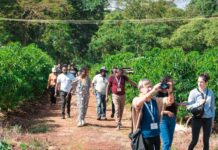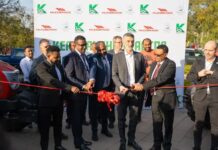A new guide published by the Center for International Forestry Research and World Agroforestry (CIFOR‑ICRAF) promises to help Kenyan local governments and communities bridge the gap between climate ambition and resources.
The Green and Climate Finance Resource Mobilization Guide for Kenyan Counties, released earlier this month, offers a practical roadmap for counties to access green and climate funds, reinforcing nationwide resilience against the twin crises of climate and environmental degradation.
A Timely Resource for a Climate‑Vulnerable Landscape
Kenya’s economy—valued at approximately USD 116 billion in 2024 and growing at around 5%—relies heavily on climate‑exposed sectors such as agriculture, water, and energy systems. Counties across the country are increasingly experiencing the dire consequences of environmental stress: deforestation, land degradation, water scarcity, and intensifying weather patterns like droughts and floods. These realities underline the need for stronger local adaptation and mitigation strategies.
Yet county governments often lack the technical expertise and institutional frameworks required to access climate funds. The new CIFOR‑ICRAF guide fills this void, presenting a structured, actionable menu for sub‑national entities to navigate climate finance systems—both domestic and international.
A Grounded Guide with Practical Tools
Developed by researchers Z. Mikwa and C. Muthuri, the guide is specifically geared toward county-level officials and local stakeholders.
It reflects CIFOR‑ICRAF’s commitment to leveraging agroforestry, forestry, landscape restoration, and natural resource management to tackle climate change and biodiversity loss.
Key features of the guide include:
- Resource mapping: Step-by-step instructions for identifying existing funding sources—from national budgets and devolved funds to international mechanisms like the Green Climate Fund and bilateral grants.
- Project preparation templates: Tools for developing strong climate project proposals, complete with budgeting, logframes, and theory of change frameworks.
- Stakeholder analysis: Guidance on identifying and engaging diverse local actors—community groups, private sector players, NGOs, and development partners—to foster collaboration and secure co‑financing.
- Institutional readiness checklists: Diagnostic tools to help counties assess their capacity across finance, governance, and human resources, alongside guidance on capacity-building and organizational development.
- Risk assessment: Processes for evaluating financial, environmental, and social risks, including strategies to reduce them and strengthen project resilience.
- Case studies from Kenya and beyond: Real-world examples illustrating successful resource mobilization strategies in similar contexts, offering valuable lessons and inspiration.
According to CIFOR‑ICRAF, the guide “offers practical strategies to help counties access green and climate finance, critical for building resilience and supporting sustainable development”.
Counties and Climate Champions Respond
The guide has already drawn praise on social media. A LinkedIn post by CIFOR‑ICRAF described it as a “valuable and timely resource for counties across Kenya”. Representatives from organizations working on land restoration in arid and semi‑arid areas—such as the Plus One Tree Initiative in Baringo County—welcomed the publication, highlighting green finance access as a key barrier to scaling impact.
In a tweet marking its launch, CIFOR‑ICRAF underscored that the guide “offers practical steps to mobilize resources for climate action at the local level”.
Overcoming Local Financial Barriers
Devolution, which began in 2013, empowered Kenya’s 47 counties to take charge of sectors like agriculture, environment, forest management, and disaster preparedness. But this local autonomy hasn’t guaranteed financial sustainability.
County budgets remain fragmented, and there’s limited capacity to integrate climate considerations in expenditures. International climate funds—such as the Green Climate Fund or Adaptation Fund—tend to favor national governments and NGOs with advanced proposal systems, sidelining county governments.
The guide tackles these challenges head-on. It helps counties:
- Formalize internal processes, enabling them to mobilize and administer funds.
- Build multi‑stakeholder coalitions, tapping into diverse expertise and co‑financing opportunities.
- Craft robust climate proposals, making counties competitive when applying for national or international support.
Officials from counties like Kisumu, Makueni, and Laikipia—regions already engaging in forest restoration and climate-smart agriculture—stand to gain significantly from this resource.
A Tool to Achieve National and Global Targets
The guide’s timing is strategic. Kenya is developing a new County Climate Change Fund framework, aimed at channeling national resources to the local level. The Intergovernmental Panel on Climate Change (IPCC) continues to stress that mitigation and adaptation are most effective when implemented at the community level.
By equipping counties with a systematic approach to finance mobilization, the guide supports Kenya’s achievement of its Nationally Determined Contributions (NDCs) under the Paris Agreement. It also accelerates progress on Sustainable Development Goals (SDGs) 13 (climate action), 15 (life on land), and 2 (zero hunger), given their interlinked nature.
Free to Download—Free to Act
The CIFOR‑ICRAF guide is freely available online. In a social media announcement, the organization urged county teams, NGOs, development partners, and community groups to “get a free copy”. By offering this resource at no cost, CIFOR‑ICRAF hopes to reduce barriers to adoption and prompt immediate application.
CIFOR‑ICRAF is also working to support guide uptake through workshops and training sessions targeting county governments, finance officers, engineers, and community representatives. These efforts, combined with the guide’s practical focus, aim to spark a decentralized wave of climate‑resilient development across Kenya.








